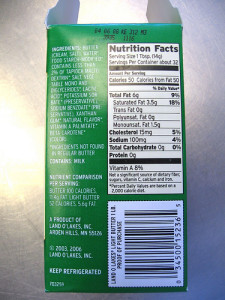Calories
Nutrition labels provide calorie numbers per serving. For example, a box of cereal doesn’t give you the total amount of calories in the box. The food label might tell you the box has 20, 1-cup servings, and that each serving has 120 calories.
Food labels also tell you what percent of daily recommended calories a serving of the food or drink provides, based on a 2,000 calorie per day diet. The FDA chose this 2,000 calorie figure for easy calculations, not because everyone should eat 2,000 calories per day. Here’s how to find your recommended daily calories.
Fats
Food labels break down the amount and types of fat a food contains. Use this information to avoid saturated and trans fats in your diet. Look for healthier monounsaturated or polyunsaturated fats. In addition to calories per serving, you’ll get the percentage of calories from fat per serving. A small can of corned beef hash may only have 250 calories, but more than 60 percent of the calories is likely fat!
Other Nutrients
Food labels don’t have to list all of their nutrients, but some, like cereal boxes, give you the breakdown for most of their vitamins and minerals. For an easy-to-use guide to nutrition labels, bookmark How to Understand and Use the Nutrition Facts Label at the FDA website.
Spotting Questionable Information
In order to make their products look as if they have fewer calories, food companies “play” with nutrition information.
•If you look at the label on a candy bar and see it’s 250 calories, be careful — the candy bar maker may claim the candy bar is two servings, so what you’re really getting is 500 calories.
•A maker of cereals will list a serving of its healthy, low-cal cereals as 1 cup, but present its higher calorie cereals in 1/2-cup per servings.
•The makers of pizza give different serving sizes for the same size pizza, depending on what topping it has. For example, a small cheese pizza label may show as two servings, while a small pepperoni pizza label might show as three servings.
Hmmm. Why do you think they do this? If you’re used to eating the cheese pizza, then look at the pepperoni label thinking it’s two servings, you’ll think the pizza has one-third fewer calories than it has!
•When you see lunch meat ham advertised as 96% fat free, you’d think that means that only 4% is fat, correct? Wrong. That’s fat by volume (don’t forget the water). The percentage of calories from fat can be closer to 30 percent! Did you buy 98% fat-free turkey breast? It’s about 20% calories from fat. These are still lean choices, but don’t think they are close to fat-free.
Additional Resources
U.S. Food and Drug Administration: How to Understand and Use the Nutrition Facts Label
